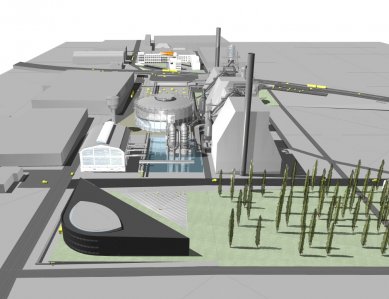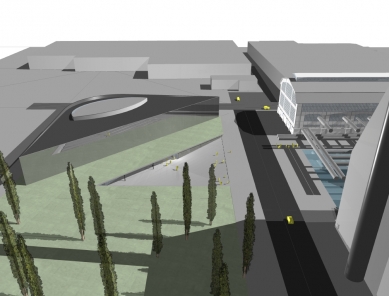
In Ostrava, the construction of a unique World of Technology will begin
Ostrava - In three years, a unique educational and entertainment center called the World of Technology will be established in Ostrava for nearly 700 million crowns. The exhibition aimed primarily at children is designed not only to entertain them but also to inspire them to study technical fields, and it will be housed in a new, avant-garde building. Construction will begin at the turn of March and April in the industrial area of Lower Vítkovice. The public contract for the construction supplier has already been announced, representatives of the Lower Vítkovice association informed today.
Rector of the VSB - Technical University of Ostrava, a member of the association, Ivo Vondrák said that it is essential to inspire young people to start creating technologies and engineering rather than just using them. "This is the key role of this center: to find talents and foster them, so they come to study technical fields, because I believe that the future of this region depends on it,” Vondrák said.
Jakub Švrček, the director of the World of Technology, stated that the deadline for the selection procedure for the construction supplier is at the end of January, and a contract should be signed with the winner in March. "We want to make the center accessible by September 2014 at the latest,” Švrček said. Jan Světlík, chair of the association's board and general director of the engineering company Vítkovice, added that work on the project has been ongoing for three years. "A lot of preparatory work has already been done. The area that is now a clear site for the construction of the World of Technology previously housed halls,” Světlík said.
The construction, including the exhibition equipment, will cost 690 million crowns. Of this, 591 million will be covered by a grant approved by the Ministry of Education. Representatives from the Lower Vítkovice stated that it is unusual for practically the same amount of money to be allocated to the equipment as to the construction. "Almost 300 million will go for the construction itself. The balance of investment in construction and equipment has been achieved thanks to excellent architecture and unique integration into the industrial area,” Švrček said.
According to the project by Josef Pleskot, the façade of the building will feature enormous mirrors that will reflect images of the industrial heritage, historic blast furnaces, gas tanks, and the VI. energy central. "The entire façade will be made of special glass that has a mirror effect. Under certain conditions, you can see through it, but at the same time, it will reflect the image of the blast furnaces, and you will see yourself in it. It will possibly be the largest interactive image in the world, approximately 130 by 15 meters in size,” Světlík said.
The interior spaces will be divided into several areas. "Without a doubt, one of the most interesting parts will be the World of Science and Discoveries and the Garden World, where we want to connect technical fields with purely natural ones. This is what fundamentally distinguishes us from other similar centers,” Švrček said.
In the World of Technology, children as young as three years old should find enjoyment. Visitors will be able to experience simulations of earthquakes, plane flights, and the functioning of various natural laws. "You can basically think of these exhibits as interactive toys. In contrast to a traditional museum, where we often read 'do not touch anything,' here we have a strict command to touch everything. Play with everything, explore everything; it will definitely be fun, and this is the best way to learn,” Švrček described the concept.
Producing the instruments will also be time-consuming. "Just defining how the exhibitions should look took our team of experts from universities in the region and teachers from primary and secondary schools two years, and we are still continuing,” said Lenka Mynářová, the head of the project’s expert team.
According to Světlík, building similar centers is a trend that Europe has fallen behind on. "They are very widespread. There are over 600 of them in China, being built in India, and around the world. They are very successful projects, and it doesn't really matter what form they take. In this region, where approximately ten million people live in the surrounding area, including Poland and Slovakia, this center is completely justified,” he said.
Rector of the VSB - Technical University of Ostrava, a member of the association, Ivo Vondrák said that it is essential to inspire young people to start creating technologies and engineering rather than just using them. "This is the key role of this center: to find talents and foster them, so they come to study technical fields, because I believe that the future of this region depends on it,” Vondrák said.
Jakub Švrček, the director of the World of Technology, stated that the deadline for the selection procedure for the construction supplier is at the end of January, and a contract should be signed with the winner in March. "We want to make the center accessible by September 2014 at the latest,” Švrček said. Jan Světlík, chair of the association's board and general director of the engineering company Vítkovice, added that work on the project has been ongoing for three years. "A lot of preparatory work has already been done. The area that is now a clear site for the construction of the World of Technology previously housed halls,” Světlík said.
The construction, including the exhibition equipment, will cost 690 million crowns. Of this, 591 million will be covered by a grant approved by the Ministry of Education. Representatives from the Lower Vítkovice stated that it is unusual for practically the same amount of money to be allocated to the equipment as to the construction. "Almost 300 million will go for the construction itself. The balance of investment in construction and equipment has been achieved thanks to excellent architecture and unique integration into the industrial area,” Švrček said.
According to the project by Josef Pleskot, the façade of the building will feature enormous mirrors that will reflect images of the industrial heritage, historic blast furnaces, gas tanks, and the VI. energy central. "The entire façade will be made of special glass that has a mirror effect. Under certain conditions, you can see through it, but at the same time, it will reflect the image of the blast furnaces, and you will see yourself in it. It will possibly be the largest interactive image in the world, approximately 130 by 15 meters in size,” Světlík said.
The interior spaces will be divided into several areas. "Without a doubt, one of the most interesting parts will be the World of Science and Discoveries and the Garden World, where we want to connect technical fields with purely natural ones. This is what fundamentally distinguishes us from other similar centers,” Švrček said.
In the World of Technology, children as young as three years old should find enjoyment. Visitors will be able to experience simulations of earthquakes, plane flights, and the functioning of various natural laws. "You can basically think of these exhibits as interactive toys. In contrast to a traditional museum, where we often read 'do not touch anything,' here we have a strict command to touch everything. Play with everything, explore everything; it will definitely be fun, and this is the best way to learn,” Švrček described the concept.
Producing the instruments will also be time-consuming. "Just defining how the exhibitions should look took our team of experts from universities in the region and teachers from primary and secondary schools two years, and we are still continuing,” said Lenka Mynářová, the head of the project’s expert team.
According to Světlík, building similar centers is a trend that Europe has fallen behind on. "They are very widespread. There are over 600 of them in China, being built in India, and around the world. They are very successful projects, and it doesn't really matter what form they take. In this region, where approximately ten million people live in the surrounding area, including Poland and Slovakia, this center is completely justified,” he said.
The English translation is powered by AI tool. Switch to Czech to view the original text source.


0 comments
add comment
Related articles
0
08.09.2014 | In Ostrava, preparations are finishing for the opening of the large World of Technology
0
14.03.2014 | In Ostrava, the Great World of Technology has temporarily opened today
0
08.01.2014 | People will be able to explore the Ostrava Great World of Technology
0
10.09.2013 | The construction part of the World of Technology is being completed in Ostrava












